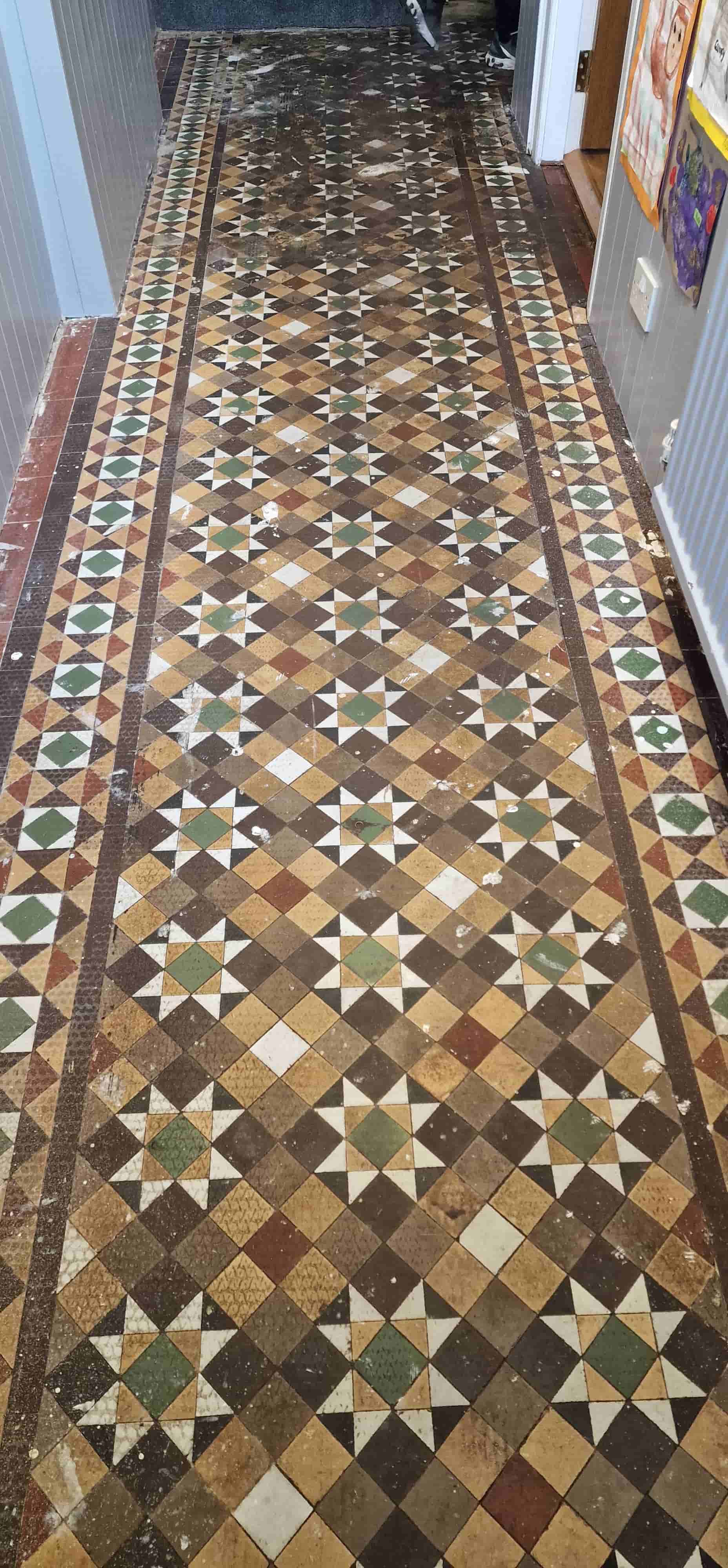As you can see from the photographs below this beautiful Victorian Tiled Hallway floor in Edinburgh was in a bad state of repair. The floor has been covered with carpet for many years and the thick adhesive had completely stained the tiles; in fact, you can still see the pattern of the underlay marking the worst parts of the tile. It could be worse as I have seen this done with gripper rods nailed straight through the tile before.
 |
 |
On top of that part of the floor had completely collapsed between the staircase and doorway to the bathroom. This would need to be raked out, backfilled with cement and then re-tilled with replacement tiles that were a close match to the original

I discussed with the client the work needed to carry out a full restoration and gave them a quote. Aware of the fact that original tiled hallways can improve the value of a property they were happy to accept and we scheduled a date for the work to commence.
Removing Carpet Adhesive from a Victorian Tiled Hallway Floor
Work started by carefully removing as much of the thick glue and underlay as possible with hand scrapers. Once done I treated the floor with Tile Doctor Acid Gel and scrubbed it in with a rotary floor buffer machine fitted with a Black pad. This generated a lot of soiling that was then extracted with a wet vacuum and the floor inspected.
It was obvious to see that more work was needed to remove all traces of the glue so I decided to switch up a gear and use more Acid Gel but this time scrubbed in with a very coarse 100-grit diamond pad followed by a 200-grit pad. Encrusted with industrial diamonds these pads are more expensive than the black scrubbing pads however using the black pad first did remove a lot of the large particles that would have otherwise clogged up the diamond pads. This process worked well and by the end of the afternoon I had managed to remove all the debris left by the carpet and glue.

Repairing a Collapsed Victorian Tiled Hallway Floor
The next ask was to focus on the collapsed section of flooring which started by cleaning out the rubble and backfilling with concrete board and cement until it was level with the existing floor.

I used around forty reproduction Victorina Tiles in this area carefully placing them to match the original pattern and cutting them to the right size where required. A fast-setting adhesive was used to fix them in place followed by grouting.

Sealing a Victorian Tiled Hallway Floor
You can’t apply a sealer to a damp floor and the tiles needed some time to dry out after the cleaning so it was around a week later before I returned to finish the work by applying a protective sealer.
Given the age of the floor I decided to apply a fully breathable sealer called Tile Doctor Colour Grow. This is an important consideration when sealing old, tiled floors as it will allow for any moisture to rise through the tile and evaporate at the surface, otherwise moisture can become trapped until the floor resulting in damp issues. Colour Grow also contains a colour enhancer that brings out the colours in the tile and works by soaking into the pores of the tile making it long lasting, again another important consideration for a busy hallway.
 |
 |
The client was very pleased with the newly restored floor, and for ongoing cleaning I recommended the use of Tile Doctor Neutral Tile Cleaner. This product has a neutral Ph which is ideal for sealed surfaces; stronger bleach-based cleaners are simply too strong for use on sealed tiles and will erode the sealer prematurely.

Source: Victorian Floor Tile Cleaning and Renovation Service in Edinburgh
Never use a strong cleaning product or steam cleaner for the regular cleaning of sealed tiles as this will reduce the life of the sealer. We recommend using a specialist tile cleaning product such as Tile Doctor Stone Soap for the regular cleaning of polished and sealed surfaces, if you do use another product always read the label first, most supermarket tile cleaners are only suitable for use on Porcelain or Vinyl tiles.